#library travails
Text
i aint ever said anything bad about my entirely customer service based work history. my customer service based work history is my best friend and i love her
#restaurant era gee and deli counter legend gee era you are getting me through these job interviews#voted americas sweetheart of every workplace ive ever been in sixth year in a row!!!!!!!!! i love my regulars and even my random customers#who just want to get their half pound of turkey and a fun fact for their day#kazoo noises#library travails
2 notes
·
View notes
Note
Kinda curious why did Theseus abandon Ariadne
Various reasons are given:
He was in love with someone else, a woman named Aigle: „she was abandoned by Theseus because he loved another woman: --Dreadful indeed was his passion for Aigle child of Panopeus.” This verse Peisistratus expunged from the poems of Hesiod, according to Hereas the Megarian, …” (Plutarch, Life of Theseus 20);
It was an accident and he came back after her: „He [Paeon the Amathusian] says that Theseus, driven out of his course by a storm to Cyprus, and having with him Ariadne, who was big with child and in sore sickness and distress from the tossing of the sea, set her on shore alone, but that he himself, while trying to succour the ship, was borne out to sea again. The women of the island, accordingly, took Ariadne into their care, and tried to comfort her in the discouragement caused by her loneliness, brought her forged letters purporting to have been written to her by Theseus, ministered to her aid during the pangs of travail, and gave her burial when she died before her child was born. Paeon says further that Theseus came back, and was greatly afflicted, and left a sum of money with the people of the island, enjoining them to sacrifice to Ariadne, and caused two little statuettes to be set up in her honor, one of silver, and one of bronze.” ((Plutarch, Life of Theseus 20);
He didn't abandon her, Dionysos simply took her from him: „[Theseus] carried off Ariadne from Crete and sailed out unobserved during the night, after which he put in at the island which at that time was called Dia, but is now called Naxos. At this same time, the myths relate, Dionysos showed himself on the island, and because of the beauty of Ariadne he took the maiden away from Theseus …” (Diodorus Siculus, Library of History 4.61.5); „And by night [Theseus] arrived with Ariadne and the children at Naxos. There Dionysus fell in love with Ariadne and carried her off; … In his grief on account of Ariadne, Theseus forgot to spread white sails on his ship when he stood for port; and Aegeus, seeing from the acropolis the ship with a black sail, supposed that Theseus had perished; so he cast himself down and died.” (Apollodorus, Epitome);
He abandoned her because Dionysos threatened him into doing so: „Theseus, seeing in a dream Dionysos threatening him if he would not forsake Ariadne in favour of the god, left her behind him there [on Naxos] in his fear and sailed away.” (Diodorus Siculus, Library of History 5.51.4); „That Theseus treated Ariadne unjustly--though some say not with unjust intent, but under the compulsion of Dionysos--when he abandoned her while asleep on the island of Dia” (Philostratus the Elder, Imagines 1.15);
He abandoned her because he feared disapproval if he were to bring her to Athens: „Theseus, detained by a storm on the island of Dia, thought it would be a reproach to him if he brought Ariadne to Athens, and so he left her asleep on the island of Dia.” (Pseudo-Hyginus, Fabulae 43);
Alternatively, he didn't abandon her at all, but she was killed by Artemis apparently as a favor for Dionysos, in which case she was probably already the consort of the god when she got involved with Theseus: „Ariadne, that daughter of subtle Minos whom Theseus bore off from Crete towards the hill of sacred Athens; yet he had no joy of her, since, before that could be, she was slain by Artemis in the isle of Dia because of the witness of Dionysos.” (Homer, Odyssey 11.320).
118 notes
·
View notes
Text


100 Days of Productivity [Day: 60] || 100 Jours de Productivité [Jour: 60]
closing my eyes at the turning of the hourglass. these days have a wonderful glow that I cannot put into words.
I was meant to spend some time working in the library today, but I decided to go for a walk instead & complete everything at home. that was the better choice, I think.
paper editing done
course work done
notes re-written
additional research completed
appointments booked
desktop organized
freelance work finished
currently listening // Andromeda by LXST CXNTURY
Je ferme les yeux en voyant le sablier tourner. Ces jours ont un éclat merveilleux que je ne peux exprimer avec des mots.
Je devais passer du temps à travailler à la bibliothèque aujourd'hui, mais j'ai décidé d'aller me promener et de tout terminer à la maison. Je pense que c'était le meilleur choix.
rédaction d'un article
travail de cours effectué
notes réécrites
recherches supplémentaires effectuées
rendez-vous pris
bureau organisé
travail en freelance terminé
chanson // Andromeda par LXST CXNTURY
#100 days of productivity#day 60#100dop#100 jours de productivité#jour 60#100jdp#studyblr#study motivation#studyspo#study aesthetic#study blog#bookish#gradblr
49 notes
·
View notes
Text

Le Petit écho de la mode, no. 3, vol. 13, 18 janvier 1891, Paris. 13. Dentelle en guipure Renaissance. Ville de Paris / Bibliothèque Forney
I pulled this plate today, and totally by chance, found myself on a Bordeaux library's website and came across an earlier version of this same plate, from 1879, 12 years earlier:

La mode française, no. 38, 20 septembre 1879, Paris. 3. — Dentelle en guipure Renaissance. Bibliothèque municipale de Bordeaux
They even have nearly identical descriptions:
Le Petit écho de la mode, 1891:
Dentelle en guipure Renaissance. — Le modèle de cette dentelle est des mieux réussi, et l’effet obtenu par son exécution des plus heureux.
Il faut comme toujours reproduire son dessin sur moleskine, ou sur percaline lustrée, puis coudre son lacet avec beaucoup de soin et comme s’il devait rester à demeure sur ladite moleskine; à certains endroits on peut se dispenser de couper son lacet, il faut bien consolider et le plus proprement possible, l’espèce de soudure si je puis m’exprimer ainsi, que l’on ne peut éviter dans la tulipe, à certaines feuilles où les brins sont trop rapprochés; on peut éviter ces coupures en repliant le lacet l’un sur l’autre, mais il faut que ce soit fait avec une grande précision, sous peine de nuire à la perfection du travail.
Dans les intervalles on fait des barrettes vénitiennes festonnées.
—
Renaissance guipure lace. — The model of this lace is most successful, and the effect obtained by its execution is most successful.
As always, you must reproduce your design on moleskin, or on glossy percaline, then sew your lace with great care and as if it were to remain permanently on said moleskin; in certain places we can dispense with cutting the lace, we must consolidate and as cleanly as possible, the kind of welding, if I may put it that way, which we cannot avoid in the tulip, on certain leaves where the strands are too close together; These cuts can be avoided by folding the lace one over the other, but this must be done with great precision, otherwise the perfection of the work will be compromised.
In the intervals we make scalloped Venetian barrettes.
La mode française, 1879:
Le modèle de cette dentelle est des mieux réussis, et l'effet obtenu par son exécution des plus heureux.
Il faut, comme toujours, reproduire son dessin sur moleskine, ou percaline lustrée, puis coudre son lacet avec beaucoup de soin; à certains endroits, on ne peut se dispenser de couper son lacet, il faut bien consolider, et le plus proprement possible, l'espèce de soudure, si je puis m'exprimer ainsi, que l'on ne peut éviter dans la tulipe, à certaines feuilles, où les brins sont trop rapprochés; on peut éviter ces coupures, en repliant le lacet l'un sur l'autre, mais il faut que ce soit fait avec une grande precision, sous peine de nuire ¡a la perfection de son travail.
L'intérieur du dessin est rempli par des jours variés.
—
The model of this lace is most successful, and the effect obtained by its execution is most successful.
You must, as always, reproduce your design on moleskin, or glossy percaline, then sew your lace with great care; in certain places, we cannot avoid cutting our laces, we must consolidate, and as cleanly as possible, the kind of welding, if I may put it that way, which we cannot avoid in the tulip, to certain leaves, where the strands are too close together; These cuts can be avoided by folding the lace one over the other, but this must be done with great precision, otherwise it will harm the perfection of the work.
The interior of the drawing is filled with varied days.
#Le Petit écho de la mode#La mode française#19th century#1890s#1891#on this day#January 18#1870s#1879#periodical#fashion#fashion plate#pattern#lace#flowers#description#Forney#Bordeaux#dress#reprint
13 notes
·
View notes
Text
A sample of my travails
I have an expression of interest or two for my posting the essays that I've been working on for my History of Art classes. I can't guarantee any real general appeal in them, but perhaps some may find them interesting, and I've been painfully silent on this forum for an extended period.
The first piece, below, is an art historical analysis of the approaches used in a chapter of E. H. Gombrich's widely-acclaimed book, The Story of Art, called 'Permanent Revolution: the nineteenth century'. I can't attach a copy of the chapter itself, but if you're really interested (and it is a very well-written book, and worthy of its reputation), then you can probably find a copy of the book at your local library. It will also give you context for the below essay. It does seem rather odd for me to publicise my university assignments, but the people have spoken, and I will appease my public.
E. H. Gombrich’s chapter, ‘Permanent revolution: The nineteenth century’, found towards the end of his master work, The Story of Art (1950), details the progression of art throughout the majority of the 1800s, through the various movements that arose in that time, and the development of thought that powered them. Through the last exciting efforts of the Romantics, the rugged truth of the Realists, to the glorious nature of the Pre-Raphaelites and, finally, the controversial rebellion of the Impressionists, Gombrich describes with enthusiasm the ebbs and flows of the art scene in Europe during this century of change, exploring the impact of the Industrial Revolution and the ways in which societies understood – or misunderstood – the work of these artists.
Gombrich actually specifies in his preface that since his intended audience are young adults, he intentionally avoids ‘pretentious jargon or bogus sentiment’ at the ‘risk of sounding casual’[1]. This casual attitude is visible in his writing style, as when he claims that something was ‘probably greater’[2] that it had ever been, and three times in the span of two paragraphs using the word ‘obvious’[3] which assumes points he hasn’t defended – although, this is not the most drastic of academic sins. Overall, his writing is very clear and readable, and his goal to write an enthusiastic and accessible, yet conceptually complex exploration of art history has certainly been achieved. The only concern might be that it is too short of a text to be called thorough, although that may be up to the individual to decide.
His overall approach whilst writing his artistic summary of the nineteenth century is a balance of social history, as is characteristic of art history scholarship in the early 20th century, with short biographical focuses. Breaking down the waves of thought into movements, rather than time periods, helps to concentrate his discussion on how artistic philosophies influenced changes in style, without falling into the fallacy of strict holistic periodisation. Within each movement, Gombrich selects two or three key figures who spearheaded the new artistic attitudes and spends some time describing their influences – past and present – and thought processes, their artistic values and the methodologies that went into creating something new. Avoiding, for the most part, elevating each artist above their surrounding community, Gombrich also effectively analyses the reception of each new movement, the conversations that were had as a result among the artists and their critics, and how those movements held some sway over the surrounding and subsequent ones in their social context. On the other hand, Gombrich’s technique of only concentrating on a few artists in each movement, for the sake of simplicity and clear reception, does tend towards implying a few solitary masters who orchestrated each artistic revolution from above, without the context of hundreds of other artists and craftsmen in studios and academies in the surrounding societies. This sort of Vasarian undercurrent is still subtly present when he refers back to fifteenth-century artists who were overshadowed by the ‘genius of Leonardo’[4] and likens this phenomenon to the impact that Renoir and the other Impressionists had on nineteenth-century painting, through Renoir’s ‘great artistic wisdom’[5]. Gombrich does point out, however, that for the most part, the artists who were popular in this period, are not the artists whom we remember[6]. As a result of this phenomenon, the artists whose so-called genius provided them with a legacy were those whose genius was recognised less by their contemporaries than by future generations, contrary to the cases of Leonardo or Michelangelo. This sort of approach focused on the individual is not an explicit aspect of Gombrich’s text, but it does sits quietly in the background; just enough to flavour his arguments without overwhelming them.
As far as historicity goes, overall, Gombrich spends most of his text comparing his artists to those who came before them, how their philosophical attitudes developed out of the previous ideas and practices, without falsely imagining that they were working towards a specific future. However, there are occasions throughout in which he seems to judge the artists’ critics of not seeing the bigger picture, so to speak, and not understanding what we now understand about their works. This isn’t necessarily an invalid position to take as regards criticism that wasn’t open to these upcoming art styles, but there is still a level of judgement felt towards the society of the time for not being advanced enough to ‘know how to look at such paintings’[7]. We might even say that Gombrich implies that certain of these movements were “ahead of their time”, which again, can’t be true; yet that remains subtle throughout. There is an interesting point that Gombrich makes in this chapter that the Impressionists began to paint nature the way they saw it, rather than what they know it looked like[8]. This concept of relying on seeing rather than knowing almost seems at first pass to be criticising the artists of the past for not understanding the visual world well enough to depict it accurately, but in reality, Gombrich explains that it is actually that they knew too much, so to speak, and that their head knowledge was getting in the way of what their eyes could see in the moment. He effectively illustrates how the development of artistic skills, to some extent, came about through a deliberate loss or chosen ignorance of what had come to be taken for granted.
Gombrich approaches the changes in the art world during this century by referring to an increase in choice of style and taste proceeding out of the Industrial Revolution, and while he describes the effects of the changes in taste, and the discrepancies between the taste of artists and their public, he seems to have missed a point in his narrative. He describes a loss of some ‘unity of tradition’[9], that perhaps may have been elaborated on in previous chapters of his book, but there is no clear explanation of what this unified tradition actually meant or consisted of, and thus we are left with a long chapter introduction that explores the effect of losing something that is essentially an unknown.
As for the effects of the Industrial Revolution, more credit could have been given to the invention of photography for altering the function of art. With the purpose of paintings and sculptures changing from records and descriptions to expressions and elaborations, Gombrich suggests that this century is the one in which a distinction is made ‘between Art with a capital A and the mere exercise of a craft’[10]. As conventions widen and expand in different directions, artists finally had the chance to express themselves in a way that they had not before – ‘where there is no choice there is no expression’[11], as he puts it – and the point he makes is that art’s progression through the nineteenth century is one of expansion, rather than a direct upward or downward trend. Art did not specifically improve or recede during this time, because the significant change was not in the area of style but of purpose.[12]
As he wrote the first edition of The Story of Art before the second wave of feminism in the 1960s, it might be too much to expect that Gombrich would mention and discuss the nineteenth-century women who contributed to the artistic canon, but nevertheless, his recurring manner of speaking of the artist as “he” is a sign of the time in which he wrote. When describing ‘what people who cared about art came to look for in exhibitions’[13], although gender is not his primary criterium, he illustrates an image of the worthwhile, sincere, artistic “man”. He does not mention a single female artist, in spite of the 1800s being a century of improved opportunity for women artists. A number of significant women were involved around the Pre-Raphaelite Brotherhood, who, as well as serving as models and muses for the men, were artists themselves, but they fail to merit an appearance in The Story of Art. The only mention of a woman in Gombrich’s whole chapter, beside the subjects of artworks, is in a quote from a critic in 1876 who degrades the Impressionists for having a woman as a founding member and critical part of their exhibitions[14]. While there is no sign of explicit degradation of women on Gombrich’s part in his text, their absence is still keenly felt by the reader who is conscious of these issues seventy years after it was published.
While not a perfect piece of art historical writing, with an unbalanced artist demographic and some non-historicist attitudes characteristic of his day, Gombrich succeeds in the primary goals of his text, and in this chapter considers a fair breadth of the important aspects of a century of art history.
[1] E. H. Gombrich, The Story of Art, London: Phaidon, 1989, vii.
[2] Ibid. 395.
[3] Ibid. 398-399.
[4] Ibid. 413.
[5] Ibid. 412.
[6] Ibid. 399.
[7] Ibid. 413.
[8] Ibid. 406.
[9] Ibid. 397.
[10] Ibid. 395.
[11] Ibid. 398.
[12] Ibid.
[13] Ibid.
[14] Ibid. 411.
#ibid#whatamarvellousword#justrollsoffthetongue#oxford#academia#history#history of art#art history#university
2 notes
·
View notes
Text
Another time-lapse of me in the library this is from a while back. The good things take time jumper is making a comeback ;)
🎵- Je Ne Veux Pa Travailler - Sympathique
#studyblr#studyspo#study video#stemblr#gatherbeingstudious#gathervideos#gatherstudies#queue ‘tis exam season#I literally wear the same clothes#since I just have like set outfits in my mind#so I’m like today I’m gonna wear set outfit 1 of something like that 😭😭#also my lips are really crusty 💀
11 notes
·
View notes
Text
Radium Girls by Cy (March 2023)

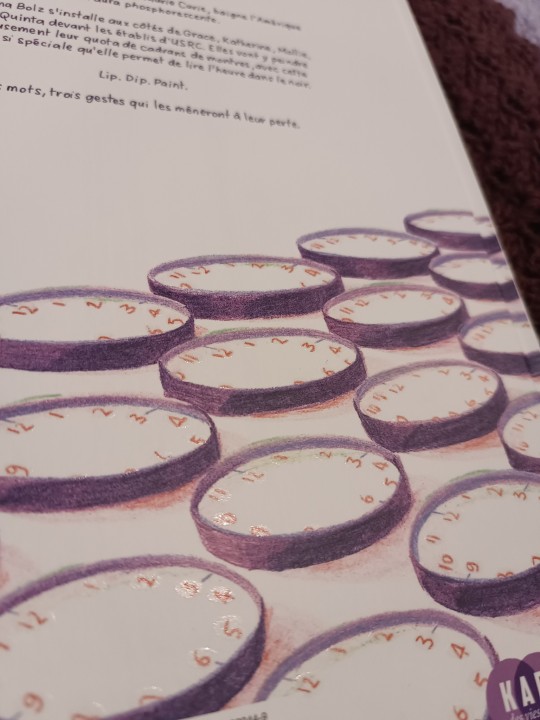
In the 1920's, the discovery of radium takes the United States by storm.
This miracle element discovered by Marie Curie bathes America in its phosphorescent aura.
In 1918, Edna Bolz sits, along with Grace, Katherine, Mollie, Albina and Quinta, in front of USRC's workbenches. There, they will meticulously paint their quota of watch faces with this very special paint that allows you to read the time in the dark.
Lip, dip, paint.
Three words, three gestures that will lead them to their death.
This is the tragic story of (some of) the Radium Girls, told through Cy's stunning art style (go check out her instagram). The use of limited colors was so smart on her part.
The story itself goes pretty fast, introducing us to this group of friends just living their life outside of work. How that works slowly starts ruining their health and their lives. We see a little bit of their fight and how the people responsible in their company did everything in their power to delay the proceedings so the girls would die before they could be judged for their actions.
Although I felt like it went a little too fast (and it kinda has to, since it's a graphic novel), it was still a great starting point if you're curious abour the story of the Radium Girls. Since it goes fast, you don't have to ingest tons of scientific details about radium, you just get glimpses of how it (and capitalism) ruined those women's lives. It's an important story to tell because it's the spark that lit the fire for the fight for workers' rights (at least in the US).
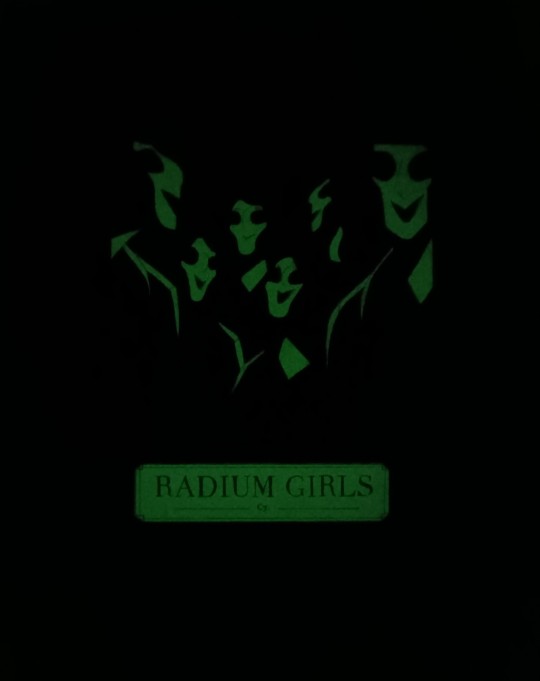

I think how I came to read this book is pretty funny so I'll leave it as an anecdote: I saw this post about the Radium Girls at the beginning of the month. Then I saw this graphic novel (sorry, it's only available in French) at the bookshop I'm interning at right now. When I asked my coworker if it was a one shot, she told me it would be 4 books but that the illustrator had another graphic novel about the Radium Girls! So I borrowed it and here we are.
French version under the cut
La découverte du radium fait une entrée fracassante dans les États-Unis des années 1920.
L'élément miracle, découvert par Marie Curie, baigne l'Amérique de son aura phosphorescente.
1918, Edna Bolz s'installe aux côtés de Grace, Katherine, Mollie, Albina et Quinta devant les établis d'USRC. Elles vont y peindre minutieusement leur quota de cadrans de montres, avec cette peinture si spéciale qu'elle permet de lire l'heure dans le noir.
Lip, dip, paint.
Trois mots, trois gestes qui les mèneront à leur perte.
Ceci est l'histoire tragique (de certaines) des Radium Girls, racontée à travers les dessins magnifiques de Cy (allez voir son instagram). Son utilisation d'un nombre limité de couleurs était vraiment un choix intelligent.
L'histoire en elle-même va plutôt vite, elle nous présente ce groupe d'amies qui vivent juste leur vie en dehors de leur travail. Comment ce travail commence doucement à détruire leurs corps et leurs vies. On voit un peu leur lutte et comment les personnes responsables dans leur entreprise ont fait tout ce qu'ils ont pu pour retarder le procès pour que les filles meurent avant qu'ils puissent être condamnés pour leurs actes.
Même si j'ai trouvé que ça allait un peu trop vite (et c'est un peu obligé vu qu'il s'agit d'un roman graphique), c'est un bon point de départ si vous voulez en savoir plus sur les Radium Girls. Vu que ça va vite, pas besoin d'ingérer des tonnes d'informations scientifiques sur le radium, on a juste des aperçus de comment il (et le capitalisme) a ruiné les vies de ces femmes. C'est une histoire importante dont il faut parler parce que l'étincelle qui a mis le feu aux poudres dans la lutte pour les droits des travailleurs (au moins aux USA).
Je trouve que la manière dont j'ai découvert ce livre est assez drôle donc je vais le raconter ici pour l'anecdote : j'ai vu ce post sur les Radium Girls au début du mois. Puis j'ai vu ce roman graphique à la librarie où je fais mon stage en ce moment. Quand j'ai demandé à ma collègue si c'était un one-shot, elle m'a dit que ça serait en 4 tomes mais que l'illustratrice avait fait un autre roman graphique sur les Radium Girls ! Du coup je l'ai emprunté et voilà.
#radium girls#cy#graphic novels#french books#french authors#romans graphiques#french#books#book recs#book recommendations#booklr#historical
16 notes
·
View notes
Text


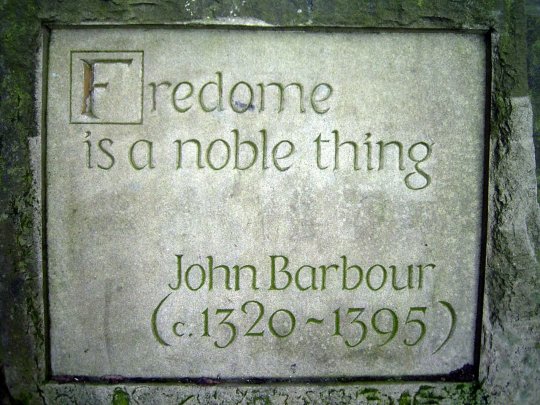
John Barbour, the early Scottish poet, died on March 13th 1395.
Barbour was a Poet, churchman and scholar, probably born in Aberdeen, where he spent most his life and held the position of Archdeacon. He was granted passage to study at Oxford and Paris. Several poems have been attributed to Barbour, one of which, The Stewartis Originall, relates the fictitious pedigree of the Stewarts back to Banquo and his son Fleance, yes they were real characters and not just made up by Shakespeare!
His long patriotic poem The Brus, awarded a prize of 10 pounds by the King Robert II, is his most famous work. It supplies some facts of Robert the Bruce, many of which are told in anecdotal style and emphasises Bruce’s exploits in freeing Scotland from English rule. This poem is also where we can find the quotation “A! Fredome is a noble thing!”
Barbour’s The Brus (The Bruce) is considered to stand right at the beginning of Scots literature and history, since it is the oldest Scots manuscript still in existence. It is an epic poem which tells the bloody tale of King Robert the Bruce, Sir James of Douglas and Edward Bruce and their fight for Scottish independence from a ruthless Edward I of England who wanted Scotland (along with Wales and France) to become part of his kingdom. The poem includes a graphic depiction of the Battle of Bannockburn, and also relates the skulduggery and intrigue that surrounded Robert the Bruce in his accession to the Scottish throne. The language is essentially that of 14th century Scotland – which by my clock makes it over 600 years old. A lot can happen to a language in 600 years. Reading it now it’s difficult to get past the weird spellings, obscure words, twisted sentence structure, etc. But if you read it aloud (not recommended in libraries), or read it into yourself and try to hear the words as they are written, then you have won half the battle.
Here is an excerpt, and translation from The Brus
…and led thar lyff in gret travaill
and oft in hard stour off batail
lwan gret price off chevalry
and war voydyt off cowardy
as wes king robert off scotland
that hardy wes off hart and hand
and gud schir james off douglas
that in his tyme sa worthy was
that off hys price and hys bounte
in ser landis renownyt wes he
off thaim I thynk this buk to ma
now god gyff grace that I may swa
tret it and bryng till endyng
that I say nocht bot suthfast thing
translates roughly to
Who led their life through great troubles,
Often in the hard struggles of battle,
And won the great prize of chivalry
And never knew what it was to be cowardly.
Such was King Robert of Scotland
Who was strong of heart and hand,
And good Sir James Douglas,
A worthy man in his time,
Who for his esteem and his generosity
Was famous in far off lands.
I make this book with them in mind.
Now God give me the grace that I may
Write it well and bring it to the end
Telling you nothing but the truth.
Imagine the world back then, to technology at all, the church was your main, if only, source of news, in the years after The Brus, the country was flushed with victory and to hear the stories of the struggles of their grandfathers, this poem sang the glories of freedom, and pictured the civic and knightly virtues of Bruce and Douglas. It’s largely thanks to this work that we know s much about King Robert and The Good Sir James.
Barbour called it a romance, it is regarded as being in essential points a faithful history, and was so received by generations of readers. Walter Scott used it for the basis of several of his books and every book that has been written about this period of Scottish history since, has used The Brus as a basis of their research.
Barbour spent much of his later life as a courtier to Robert II, who commisioned The Brus and The Stewartis Originall, although the latter is highly embellished to put the Stewarts in a much better light, Robert II being the first of their line would have been the source for Barbour to write the story. As well as the ten pound he received for writing The Brus, the King also granted Barbour a pension of a pound a year for the rest of his life. He went on to write a number of other poems, though most have been lost and the authorship of others is debated. The 33,000 line poem Legends of the Saints was probably written by him, as was as The Scots Buik of the most noble and vailyzeand Conqueror Alexander the Great.
Many view him as the father of Scots language poetry. As well as being in Robert II court, Barbour continued to fulfil his duties at St Machars’ Cathedral until the early 1390s, and he died in Aberdeen in 1395, a plaque in the city remembers him.
The pictures include one of the two earliest surviving manuscripts of The Brus, it shows a description of the initial phases of the battle of Bannockburn. This is a copy made by John Ramsay, Prior of the Carthusian monks at Perth, made this copy of the poem in 1489 and is held at The National Library of Scotland. The link takes you to the NLS page with and interesting timeline and links to important documents held in their archives
The second pic is on the walls of The National Portrait gallery, a magnificent frieze of Scottish history, the aforementioned plaque, that can be found at Castle Street, Aberdeen, and finally the slap at the top of the mound fittingly marking the steps up to Makar’s Court in Edinburgh’s Old Town, the full stanza reads
A! Fredome is a noble thing!
Fredome mays man to haiff liking.
Fredome all solace to man giffis,
He levys at es that frely levys!
It translates to
Freedom is a noble thing!
Great happiness does freedom bring.
All solace to a man it gives;
He lives at ease that freely lives.
Pics are a memorial to John Barbour at St Machars, Aberdeen, an 18th century copy of his work in The National Museum of Scotland and the above mentioned inscription at The Mound, Edinburgh.
14 notes
·
View notes
Text
Vendredi 28/07 - N'est pas Michael Scofield qui veut
Pac & Mike sont emprisonnés chacun dans une cellule se faisant face. Cucurucho leur a fourni un livre contenant les raisons pour lesquelles ils sont emprisonnés.
Ils ont pu apercevoir le planning des prisonniers. Ils ont reçu le manuel du prisonnier. Ils ont aussi croisé WalterBob, qui "vit ici depuis des années", ainsi que des gardes.

Après avoir pris un repas, ils ont été forcé de travailler. Leur premier boulot : construire une petite maison. Ils ont récupéré 2 points en faisant une petite maison en bois. Ils ont évidement essayé de crafter une épée et un bateau pour s'échapper, mais les gardes ont fait des fouilles pour être sûr qu'ils n'aient rien dans leur cellule.

Walter et Tazercraft ont discuté un peu (Walter les croit quand ils disent n'avoir rien fait) et il leur a révélé que les gardes vérifient les cellules toutes les 2h. Walter, la nuit, a donné les codes des cellules à Tazercraft (qui ont pu voir la cellule triste de WalterBob).
twitch_clip
https://clips.twitch.tv/SaltyPuzzledBoarUncleNox-s-6SpEN8cxWLkiCb
En se baladant dans la prison, Pac&Mike ont trouvé une cellule avec des panneaux marquant "TO BE TRANSFERED SOON", et "SHHH". Au réveil, après déjeuner, ils ont eu a "construire quelque chose de beau", avec pour ressource de la cobblestone et des minerais. Ils ont eu l'idée de cacher des outils de contrebande dans la poubelle de leur inventaire. Après avoir crafté un bloc de diamant / or / fer, ils ont obtenus 3 points supplémentaires. Walter bob a précisé qu'il avait réussi a garder une pioche en fer sur lui.
Le plan pour la nuit : aller à la cuisine pour ouvrir une porte là bas. WalterBob leur a dit qu'il y avait quelque chose au 2eme étage, mais qu'il n'aimait pas y aller et qu'il n'irait pas.

Après le dîner, il furent convoqués pour un interrogatoire. Tout d'abord, le policier lui a demandé ce qu'il faisait avant d'être emprisonné. Ensuite, il lui a demandé s'il avait des infos sur Mr Mustard (Pac a répondu qu'il ne l'avait quasiment jamais vu). Puis, Pac fut questionné à propos d'objets créatifs volés à la fédération. Il a répondu qu'il n'était pas au courant que ça appartenait à la fédération. Lorsque l'agent s'est retourné pour aller voir le chien des gardes (nommé Poncho), Pac en a profité pour voler les clés qui trainaient dans son sac. Enfin, l'agent lui a demandé s'il avait un casier judiciaire, Pac a répondu qu'effectivement, ils ont déjà été en prison à Alcatraz, mais il a servi sa peine. Il a précisé qu'il était avec Cellbit à ce moment là.
twitch_clip
https://clips.twitch.tv/RealMagnificentSnailDatBoi-IL59gJnAe5XTHMsP
Pendant la nuit, Walter les a emmené vers la cellule avec les panneaux et les lumières clignotantes. Les panneaux se sont mis a écrire "How are you ?", "Do you want to escape ?" puis "Go to the music room" et "Go to the library".
Lors de la nouvelle journée de travail, ils ont du construire une école, ce qui leur a rapporté 2 points supplémentaires.

De son côté, Fit a reçu sa première mission de Cucurucho : Nettoyer la salle des derniers moments du cimetière, et poser des caisses de patates, oignon, carotte, tomates et choux. Dans un coffre caché sous la cendre, il a trouvé un livre disant que les données des joueurs ont du être bougées, à cause d'un risque de sécurité. Il faut visiter [redacted] pour retrouver, soumettre ou éditer les données. En nettoyant, il a aussi trouvé une plaque de téléportation, qui l'a emmené... A la cuisine de la prison !
Pac&Mike ont eu l'autorisation, avec Walter, d'aller dans la salle de musique et la bibliothèque. Dans la bibliothèque, ils ont trouvé un livre sur le système de sonar.

Fit a trouvé un nouveau livre dans la cuisine, parlant d'un compte Minecraft [redacted]. Finalement, lui et Tazercraft ont fini par rentrer en contact. Pac lui a expliqué que c'était une prison, et qu'ils étaient piégés ici. En fouillant un peu, Fit a trouvé un livre (30/?). Néanmoins, il a été vu par Cucurucho, qui lui a mis un coup de poêle, et l'a téléporté à nouveau dans le cimetière.
Pac&Mike ont supposé devoir jouer de la musique pour pouvoir ouvrir une porte via le système de sonar. Dans la bibliothèque, ils ont trouvé une porte vers une salle ressemblant à un jeu d'echec. Ils ont trouvé une grille avec l'emplacement des pièces du jeu. En résolvant l'énigme du jeu d'echec, Walter Pac a trouvé un plan de la prison.
Fit a fait sa livraison de caisses de nourriture à la prison. Ramon a précisé à Fit qu'il ne devait pas parler de ce qu'il avait vu, car ils ne savent pas à qui/quoi ils ont à faire, et ça pourrait mettre Tazercraft et eux même dans une merde beaucoup plus grosse que ce qu'ils peuvent imaginer.

Via le plan de la prison, ils ont fini par trouver une salle secrète menant à une ventilation éteinte. Ils ont fini par réussir a ouvrir la porte de la cuisine, mais la warp plate n'était plus là. Ils sont de retour en prison. WalterBob ayant été pris en même temps qu'eux, il s'est fait punir pour ses crimes à coup de poêle et de tazer.
Après avoir trouvé miraculeusement de la redstone et de l'andésite, dernière pièce manquante pour faire marcher la ventilation, ils ont retrouvé WalterBob, triste dans sa cellule, pour lui donner du pain et l'encourager à s'enfuir avec eux. En créant un arbre de rotation, ils ont réussi a ouvrir une porte vers la salle de musique.
twitch_clip
https://clips.twitch.tv/KawaiiSleepyAlfalfaBCouch-uVphLw2bzyYfdq3_
En voulant s'enfuir, ils se sont fait intercepter par un garde, qu'ils ont tués. Ils ont récupéré une carte d'accès sur lui, mais la carte ne marchait pas. Ils ont finalement trouvé une autre sortie, qui les a emmené vers une Waystone ! Walterbob (et Tazercraft) sont sauvés !
Tazercraft ont offert la maison Barbie à WalterBob ! ... Néanmoins, un agent de sécurité est arrivé, et a enlevé WalterBob sous les yeux de Pac et Mike. L'agent de sécurité a laissé un message à Tazercraft, disant qu'ils ne reverront jamais WalterBob par vengeance de son collègue tué.
twitch_clip
https://clips.twitch.tv/BrainyObliviousAdminRalpherZ-EHiGezQ8ErF0aYZh
Foolish est vu comme un traitre auprès de ses pairs. Forever lui a crié dessus, Fit a donné l'autorisation à Ramon de le tuer.
Fit a reçu une visite de Cucurucho, il a décroché le job d'agent d'entretien de la fédération !
twitch_clip
https://clips.twitch.tv/HumblePunchyHawkMingLee-X7sHmznl575tEALw
Cucurucho a rendu une visite à BBH suite à son appel, néanmoins, il n'a pas joué de son avec sa soundboard, et lui a donné un livre entièrement en minuscule, contrairement à son habitude. Il est parti sans rien dire. BBH et Foolish se demandent si le code pourrait avoir un moyen de se déguiser en Cucurucho aussi.
Foolish a commencé un rituel avec Jaiden et Leonarda pour faire réapparaître Mr. Mustard. Cucurucho les ont interrompus… Foolish lui a demandé s'il savait où était Mr. Mustard (vu qu'il a emprisonné Tazercraft pour ça), Cucurucho a répondu "peut-être". Puis, après plusieurs minutes d'absence, il a proposé à Foolish de l'accompagner (seul ou à plusieurs, Foolish a proposé a Jaiden et Leo de venir).
Ils ont été envoyé à la prison. Malgré le déni de Cucurucho, ils ont bien compris que ce n'était pas que des bureaux, mais bien un pénitencier. Cucurucho lui a offert l'opportunité d'être l'enquêteur officiel de la fédération sur la disparition de Mr.Mustard. On lui a remis le dossier d'enquête, et après avoir accepté le boulot, Foolish a reçu son badge !
twitch_clip
https://clips.twitch.tv/ToughAdorableSnoodNotATK--0fgtGimN-YwH1ps
3 notes
·
View notes
Text
Best Sumeru theory I’ve seen so far
(https://bbs.nga.cn/read.php?tid=32870139). Below is my translation of the post:
I studied the English version of the Sumeru PV, and then reviewed the other few versions, and now I feel like Rukkhadevata may have done something big in Sumeru.
In the English version, the system created by Rukkhadevata was translated as “Akasha”. This word is a phonetic translation of the original word in Sanskrit, but the original meaning isn’t “another world outside of the material world” like how it appears in many other games, but it actually means “the sky” or the concept of space itself. In Sanskrit, Akasha is regarded as the origin and foundation of all beings and all things (since everything takes up a certain amount of space). Later, as ancient Indian philosophy was introduced into Western mysticism in the 18th-19th century, Western mysticism came up with the “Akashic Records”. Basically, in this concept, there is an “Akashic Record” in the purely spiritual “Akasha”, which recorded everything in the universe: past and present, all events, all thoughts. If you have a way to read the Akashic Record, you will be able to find anything you want.
Coincidentally, there is such a record in Genshin: the ley lines. One of the loading screen messages explained how the ley lines worked, I don’t remember the exact words, but I think it’s roughly “the ley lines recorded everything that has happened” (original text from the wiki: “A mysterious network that links the whole world together, within which flow the elements. It's said the Ley Lines remember all things that happen in this world, from the surface down to the deepest depths...”). So ley lines is half of the “Akashic Record” (since it does not record future events). Maybe Rukkhadevata, for reasons unknown, used their gnosis to create a thing that allows humans to access and retrieve information in the ley lines, and after Rukkhadevata died, the people of Sumeru started to use the Akasha system to tap into the knowledge stored within the ley lines more and more, without inhibition or moderation.
Also, if Akasha is really the “server” that connects to the ley lines, that can explain how the Akademiya turned knowledge into a resource and used that to govern Sumeru. Because if the Akademiya is only a research institution that stores knowledge and lets people write academic papers, then it should not hold a lot of power over the researchers. An organization like this relies on the “production” of knowledge from the researchers, but the lore did not mention the Akademiya giving grants to the researchers like in Fontaine, where if the Fontaine researchers don’t complete their research they had to appear before the court. But if Akasha is a “server” that lets users access the Ley Lines, then things are very different. The Akademiya can reserve the power to grant or deny access permission. It’s like if a person wants to write academic papers, but only the Akademiya can decide who gets to access the library, which library, and for how long. This way the Akademiya can hold authority over people.
In the “Travail” trailer, (Dainsleif’s) comment for Sumeru is “in the city of scholars there is a push for folly”. As we all know, messing with the Ley Lines in the world of Genshin never ends well.
Another interesting thing is in the “A Winter Night’s Lazzo” PV, Collei saw Dottore burning a tree. In his dialogue with Columbina, Dottore said that Segment was carrying out a “little experiment in ‘blasphemy’”.
So, if my guess regarding Akasha is correct, then the tree that Dottore burned could be Akasha. Because lore-wise, Snezhnaya will definitely collect all of the gnoses, and if the Fatui were to get the dendro gnosis, they must first destroy the Akasha “server” that is based on this gnosis. Destroying the legacy of the previous Dendro archon does count as “blasphemy”. Judging by the future direction of the lore, the Akademiya doesn’t seem to be a good organization, so if Akasha does have something to do with the Ley Lines, then the current Dendro archon has a good reason to destroy Akasha in order to prevent any future f**k-ups from the Akademiya.
So here’s my bold prediction, maybe Sumeru’s situation is similar to Liyue, where the Dendro archon consented to the actions of the Fatui, and even used the gnosis as a reward to force the Fatui to destroy the Akasha system.
#genshin impact#genshin theory#sumeru#akasha#ley lines#sumeru akademiya#fatui#greater lord rukkhadevata#lesser lord kusanali
30 notes
·
View notes
Text
Proud to announce I’m finally fucking free from the tyranny of late work for my cataloging class
#kazoo noises#unfortunately now I have to submit to the late work of my history class#The captain goes down with his scholarship#library travails
2 notes
·
View notes
Photo

Artist - Sugar
Song - 新入社員と とらばーゆ (A.M. 9 to P.M. 5) (Shinnyu Shain To Travail)
[Eng. "New Employee And Work (9 A.M. To 5 P.M.)"]
Release Date - April 1982
Listen 🎶
https://rumble.com/v2p9xqe-sugar-shinnyu-shain-to-travail-a.m.-9-to-p.m.-5.html
My blog: Showa Music Library
https://nobbykun.tumblr.com/
3 notes
·
View notes
Text
Update on my Sumeru Exploits!
Highest point in Sumeru! (atop the tree of Sumeru city) You really can see everything fhjdjssj you'll get an achievement too!

Found this near the edge of the map! I think they were about to battle or something. You have to fight them to get the luxurious chest and the dendroculus on top of the branches.

Finished the new Mortal Travails! Now I have all of them dhsjakak
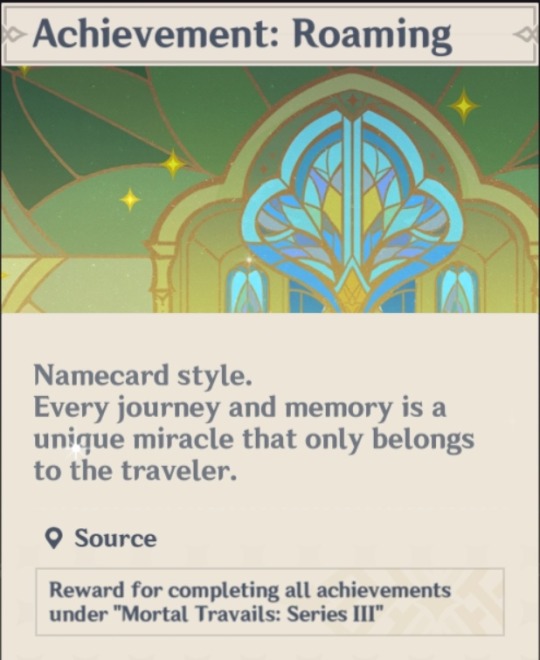
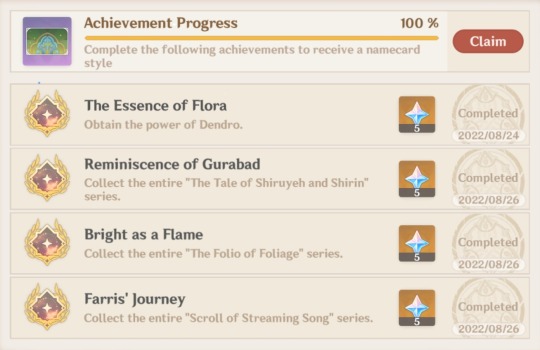
You can find all of the books in the library in Sumeru City, as well as some other ones that'll be important for lore later.
#longer post#aethers gaming#genshin impact#sumeru#i also got almost all the teleport waypoints and lit up the map#I'll have to figure out how to get that last one and the domains another time#next up i finally start the archon quest lmaooo
12 notes
·
View notes
Text
"Eileithyia received care of expectant mothers and the alleviation of the travail of childbirth; and for this reason women when they are in perils of this nature call first of all upon this goddess. And Artemis, we are told, discovered how to effect the healing of young children and the foods which are suitable to the nature of babes, this being the reason why she is also called Kourotrophos." - Diodoros of Sicily, Library of History
5 notes
·
View notes
Note
seeing you like my fic:

KAKSKA PLSSS I WAS REREADING MY FAVE SPENCER ENEMIES TO LOVERS FICS AND I REALIZED I’D NEVER ACTUALLY PRESSED THE LIKE BUTTON </33
Catch me rereading Langue d’amour and Bourreau de travail on a daily fucking basis though they are sTAPLES in my library 💪🏼
5 notes
·
View notes
Text
Recap de décembre à février 2024
#Dédicace pour #Toutes #Tous
Vie Amour Joie Vérité Travail Échanges
#Plaisir #Harmonies #Hertz #pans
#Positive love #Courage
#Vérité2024 #True2024 #Verdad2024
🌍🤝🚻 #Peace #vibzzzzs @C-Vince
🇨🇵🦾💚🥁 #PAIX #loovince aka 🍷💯
058117106 #Liban1982 à 17ans
T47 chaufferieAvant chefdefeux
mazout amiante chemicals synthétics
#Défensenationale #OutresMers 🌿
papa Papy parent Parrain Tonton Patriote Français citoyen contribuable
#Handivibzzs ♿🙋🥁🧠#Handiboost
#VIVElaVIE. Famille #PLAISIR Fermeté
#Valeurs : 🌍🚻🇨🇵🧬🧠🥂🙏🥋🕊️: #pasderacesuperieure
#Jésusprincipes #Shambala #Aqua
#Bénédiciones de Santa Maria de Guadalupe. Azulita Natura Azul Verde
0 notes